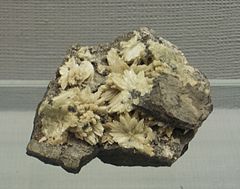Collinsite
| Collinsite | |
|---|---|

Crystals of collinsite from the Rapid Creek area of northern Yukon, Canada
|
|
| General | |
| Category | Phosphate mineral |
|
Formula (repeating unit) |
Ca2(Mg,Fe2+)(PO4)2·2H2O |
| Strunz classification | 8.CG.05 |
| Dana classification | 40.2.2.3 |
| Crystal system | Triclinic |
| Crystal class | Pinacoidal (1) (same H-M symbol) |
| Space group | P1 |
| Unit cell | a = 5.734(1) Å b = 6.780(1) Å c = 5.441(1) Å α = 97.29°, β = 108.56°, γ = 107.28°; Z = 1 |
| Identification | |
| Cleavage | Fair on {001} and {010} |
| Tenacity | Brittle |
| Mohs scale hardness | 3 to 3.5 |
| Luster | Subvitreous, silky if fibrous |
| Streak | White |
| Diaphaneity | Translucent |
| Specific gravity | 2.99 |
| Optical properties | Biaxial (+) |
| Refractive index | nα = 1.632 nβ = 1.642 nγ = 1.657 |
| Birefringence | δ = 0.025 |
| 2V angle | 80° (measured) |
| Dispersion | r < v strong |
| Ultraviolet fluorescence | Non-fluorescent |
| Solubility | Readily soluble in acids |
| References | |
Collinsite is a mineral with formula Ca2(Mg,Fe2+)(PO4)2·2H2O. It was discovered in British Columbia, Canada, and formally described in 1927. It was named in honor of William Henry Collins (1878–1937), director of the Geological Survey of Canada. There are three varieties of the mineral: magnesian collinsite, zincian collinsite, and strontian collinsite. The crystal structure consists of polyhedral chains linked by weak hydrogen bonds.
Collinsite is translucent and brown, chocolate-black, light brown, yellowish white, white, or colorless. It is colorless in thin section and light yellow-brown to colorless in transmitted light. The zincian variety of collinsite is pale blue. The mineral can occur with fibrous habit, as globular aggregates of crystals, as concentrically layered botryoidal masses, or as bladed or prismatic crystals up to 2 cm (0.79 in).
Collinsite is a member of the fairfieldite group.Hillite is the zinc analogue of collinsite and collinsite is the magnesium analogue of messelite.
There are three varieties of collinsite:
Magnesian collinsite was described from South Dakota in 1972, zincian collinsite was described from South Australia in 1973, and strontian collinsite was described from Russia as early as 1965. The replacement of calcium by strontium that occurs in strontian collinsite is atypical of collinsite.
The crystal structure of collinsite was determined using essentially pure magnesian collinsite, Ca2Mg(PO4)2·2H2O, and published in 1974. It consists of chains of corner-sharing (MgΦ6) octahedra and (PO4) tetrahedra. Four of the Mg ligands link to (PO4) groups and the other two to water molecules. Two of the ligands in the (PO4) group link to (MgΦ6) octahedra and the other two link to calcium atoms and act as hydrogen bond acceptors. Weak hydrogen bonds link chains together and force separation between them. The separation gives room for interstitial, eight-coordinated calcium between chains.
...
Wikipedia
